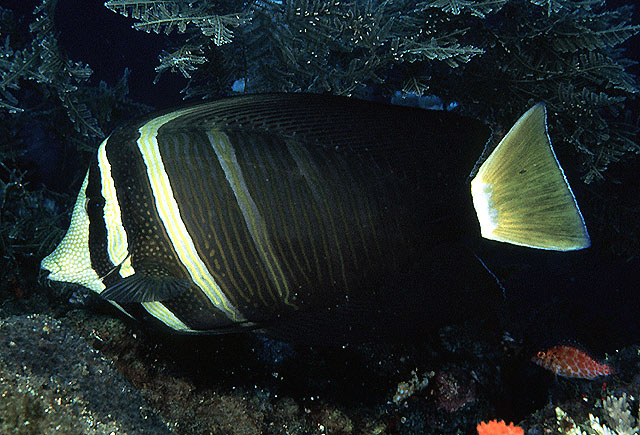| Acanthuridae (Surgeonfishes, tangs, unicornfishes), subfamily: Acanthurinae |
| 40 cm SL (male/unsexed) |
|
reef-associated; marine; depth range 0 - 45 m, |
| Eastern Indian Ocean to the Pacific Ocean: Christmas Island and most of the East Indian region to South China Sea, Hawaii and Pitcairn Islands; north to Japan and Ogasawara Islands; south to western and eastern Australia; Replaced by Zebrasoma desjardinii in the Indian Ocean. |
|
Dorsal spines (total): 4-5; Dorsal soft rays (total): 29-33; Anal spines: 3-3; Anal soft rays: 23-26. Smalls juveniles have alternating yellow and black bars. No brush-like patch of setae posteriorly on side of body. Dorsal fin very elevated, the longest ray 2.1 to 2.5 times in SL (Ref 9808).
Description: Characterized further by having dorsal and anal fins with dark grey to brownish in color, with pale bands; caudal fin grey to yellow; caudal peduncle with retractable spine present on each side; greatest depth of body 1.8-2.0 in SL (Ref. 90102). |
| Benthopelagic (Ref. 58302). Occurs in lagoon and seaward reefs from the lower surge zone to a depth of at least 30 m. Solitary juveniles found among rocks or coral (Ref. 58534) of shallow protected, sometimes turbid reefs (Ref. 1602, 48637). Feeds on leafy macroalgae. It possesses, fewer and larger pharyngeal teeth, compared to the other Zebrasoma spp. (Ref. 33204). Diurnal species (Ref. 113699:32); courtship and spawning takes place from morning to afternoon and is often confined to ebb tides (Ref. 38697). The species is never poisonous (Ref. 4795). Minimum depth reported taken from Ref. 128797. |
|
Least Concern (LC); Date assessed: 07 May 2010 Ref. (130435)
|
| harmless |
Source and more info: www.fishbase.org. For personal, classroom, and other internal use only. Not for publication.

